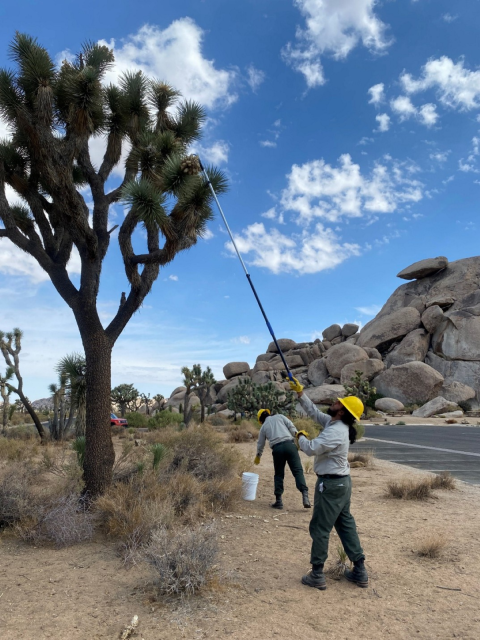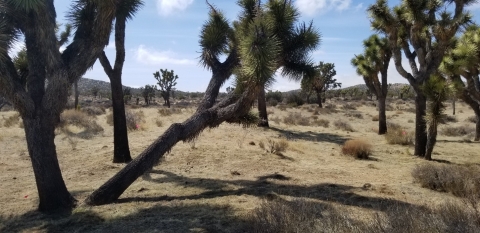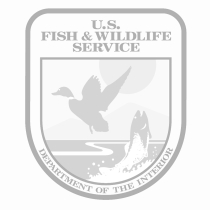Location
States
CaliforniaEcosystem
DesertIntroduction
Joshua Tree National Park (JOTR), located in Southern California, spans diverse ecosystems across three major bioregions, Mojavean Desert, Coloradan Desert, and cismontane chaparral. These bioregions include two distinct deserts, the drier Colorado Desert to the south and east and the slightly higher elevation, and more moist Mojave Desert to the north and west. The area JOTR encompasses spans elevations of 500 to approximately 5,800 feet and receives 5 to 12.5 inches of annual rainfall.
JOTR was established in part to protect the Joshua tree (Yucca brevifolia), an integral component of the Mojave Desert. Currently, Joshua trees and their habitat are threatened by a warming climate, more frequent and severe droughts, and the spread of invasive grasses and forbs that are increasing the frequency, size, and severity of wildfire. In addition to Joshua trees, JOTR protects desert wildlife including, but not limited to, the threatened desert tortoises (Gopherus agassizii) and the rare pallid blue-dotted butterfly (Euphilotes pallescens elvirae) that are also facing pressures from changing climate and fire regimes.
The National Park Service uses the Resist Accept Direct (RAD) framework for understanding where, when, and how to implement adaptation projects to respond to the pressures of a changing climate and fire regime (Schuurman et al. 2020). JOTR staff and their partners are using data about future climate conditions to understand which areas of JOTR will retain viable Joshua tree habitat under future climate scenarios. This data helps staff decide where and when to Resist changes to Joshua tree populations and habitat by installing and maintaining fuel breaks, when to Accept the decline in suitable Joshua tree habitat, and when to Direct the trajectory of change by replanting burned areas with Joshua trees that are more drought adapted (Schuurman et al. 2020). Using the RAD framework and data about future climate conditions helps JOTR staff make informed management decisions to effectively conserve the existing Joshua tree population and maintain habitat integrity for both Joshua trees and endangered desert wildlife under future climate scenarios.
Key Issues Addressed
JOTR’s desert ecosystems are naturally fuel-limited landscapes. The sparse distribution of vegetation in undisturbed desert landscapes limits the spread of fire. As a result, Joshua trees are not adapted to extreme fire behavior and have not been found to reestablish well after fire (DeFalco et al. 2010). The increase in abundance of invasive species such as red brome (Bromus madritensis) and cheatgrass (Bromus tectorum), sped up by increased atmospheric nitrogen deposition(Sweet et al. 2019), water resource competition, and tolerance to drought and fire, has resulted in continuous fuel loads across the landscape, increasing the size, frequency, and severity of fire in JOTR. This increase in fuels increases the risk of widespread fire, which can in turn increase risk of Joshua tree mortality.
Climate change is predicted to prolong drought, increase summer and winter temperatures, and reduce annual rainfall. Average temperatures in the 1981-2010 period were 0.46॰C higher than the previous 30 year period, and climatic water deficits have increased by an average of 36mm (Sweet et al. 2019, table 3). These changes threaten current Joshua tree populations and shrink the areas of long-term suitable habitat for Joshua trees at JOTR in the future. As climate change climate change
Climate change includes both global warming driven by human-induced emissions of greenhouse gases and the resulting large-scale shifts in weather patterns. Though there have been previous periods of climatic change, since the mid-20th century humans have had an unprecedented impact on Earth's climate system and caused change on a global scale.
Learn more about climate change progresses, future viable Joshua tree habitat in JOTR is predicted to shrink significantly (Sweet et al. 2019).
JOTR is also responsible for monitoring and maintaining the habitat and populations of the threatened desert tortoise and rare pallid dotted-blue butterfly. Desert tortoises are not adapted to frequent, high-severity fire across large areas, and are therefore extremely vulnerable to fire. The habitat of the pallid dotted-blue butterfly is restricted to portions of the park that contain yucca buckwheat (Eriogonum plumatella), a critical host plant for the pallid dotted-blue butterfly’s life cycle. Disturbance from small, low-severity fires may be beneficial for butterfly habitat by reducing cover of woody plants and opening habitat for yucca buckwheat to establish. However, pallid dotted-blue butterfly habitat is sensitive to the effects of climate change and the spread of invasive grasses. Large frequent fires may be detrimental to the pallid dotted-blue butterfly if they are severe or large enough to significantly reduce butterfly populations or reduce cover of yucca buckwheat. Furthermore, common fire management practices such as vegetation removal and herbicide use can have detrimental impacts on butterflies and their habitat if not implemented with the life cycles of these species in mind.
Project Goals
- Establish fuel breaks to reduce heavy fuel loads and restore a fuel-limited vegetation structure to limit the spread of high-severity, high-intensity fire. Completing fuels reduction includes removing invasive species and reducing the density of native species, through mechanical vegetation removal and mindful use of herbicides to establish fuel breaks without disturbing the life cycle of the pallid dotted-blue butterfly.
- Preserve and restore the refugial populations of Joshua trees. Use climate modeling to identify how much of current Joshua tree habitat will be unsuitable for the species in the long term and identify areas most suitable for the species under future climate scenarios.
- Propagate Joshua tree seeds from distinct subpopulations across the park in a common garden experiment to better understand which subpopulations have characteristics most suited to long-term survival in a hotter, drier future.
- Protect desert tortoises and pallid dotted-blue butterfly habitat by developing restoration initiatives, developing educational programs meant to emphasize the importance of protecting both species before implementing fuel reduction projects, and preserving buckwheat plants to not interrupt the life cycle of the pallid dotted-blue butterfly.
Project Highlights
Fuel Breaks to Resist Fire and Climate Change: In 2021, JOTR implemented fuel breaks along 9.2 miles of Covington Flats Road to prevent future fires from spreading extensively and allow firefighters safe access to protect unburnt Joshua tree habitat. JOTR used chainsaws and brush trimmers to thin 60-70% of woody plants within 15 feet of both sides of the road and removed 70-80% of fine herbaceous fuels up to 30 feet from both sides of the road using string trimmers and hand tools. Approximately 30-40% of native grasses were removed. JOTR did not remove any Joshua tree, yucca, cactus, or pine plant material even if the plant was downed because the plant can still provide habitat for wildlife.
Replanting Guided by Future Climate Models: It is hypothesized that Joshua trees from the drier parts of the park will do better in a hotter, drier climate. Climate models predict that there will be an 80-99.8% reduction in viable Joshua tree habitat at JOTR by the end of the century (Sweet et al. 2019). With higher temperatures, Joshua trees will face increased drought stress in the remaining 0.2-20% of habitat in JOTR that remains viable under future climate conditions. To find populations of Joshua trees with genetics best suited to future climate, JOTR staff grew trees in a nursery for 12-18 months using seeds that came from 14 areas of the park with different temperature and rainfall conditions.
Replanting Guided by Climate & Population Models: Climate and population models predictincreased temperatures and climatic water deficit, and an 80-99.8% reduction in viable Joshua tree habitat at JOTR by the end of the century (Sweet et al. 2019). Because increased temperatures will exacerbate drought stress for Joshua trees in remaining 0.2-20% of remaining habitat, It is hypothesized that Joshua trees from the drier parts of the park will do better under future climate scenarios. Therefore, JOTR staff conducted a common garden experiment where they collected seed from 14 subpopulations representing microhabitats across a temperature and precipitation gradient to find populations of Joshua trees with genetics best suited to future climate. Seeds from the most successful individuals will be used for future planting efforts.
Replanting in Burned Areas: To combat large-scale Joshua tree mortality, JOTR has developed a Burned Area Recovery plan. JOTR strategically replants Joshua trees and associated species along the edges of washes and roads so that Joshua trees can use captured rain, maximizing the likelihood of survival. In some cases, Joshua trees are planted in 2.5 acre “restoration islands” within burned areas using nursery-grown trees sourced from seed stock within JOTR. These restoration islands are located in areas that already have seed sources and may have higher soil moisture compared to other areas of the park. Planting takes place over multiple years and is timed before winter rains to reduce likelihood of mortality from drought. To maximize soil moisture, JOTR staff use berms, mulch, and shade cloth on cages. Young Joshua trees are watered upon planting, and chicken wire is installed to protect them from herbivores such as rabbits and rodents. When planted trees are close to roads, watering can continue for 2-3 years to help establishment but this is not often possible.
Preserving and Maintaining Endangered Wildlife Populations: To develop ecosystem restoration and fuel break maintenance projects, JOTR staff participated in mandatory desert tortoise habitat training. The training helped staff understand how to support tortoises when conducting Joshua tree restoration treatments. Additionally, because of the rarity of the pallid dotted-blue butterfly, JOTR avoided fuel removal treatments in areas of the park where the butterfly is known to reside to preserve as much undisturbed butterfly habitat as possible. Without proper consideration of the butterfly’s life cycle, removal of certain desert vegetation as a fuel treatment can cause harm. Despite these concerns, fuel breaks are still implemented in pallid dotted-blue butterfly habitat to protect the ecosystem and the butterflies from high-severity fire.
Lessons Learned
JOTR staff and their partners implement and maintain fuel breaks to reduce the spread of fire when ignition occurs. Reducing the cover of invasive grasses in fuel breaks is critical to ensuring the continued efficacy of fuel breaks. Staff and partners used pre-emergent herbicides to manage and prevent new growth of invasive grasses such as red brome and cheatgrass, and post-emergent herbicides to inhibit the development of existing growth. Staff and partners learned that paying attention to the life cycle and germination periods of invasive grasses can help determine the best time to apply herbicides. They used indaziflam (Rejuvra), a pre-emergent herbicide, to prevent growth of invasive grasses and found that it had minimal impact on native perennial vegetation.
Staff at JOTR and their partners used species distribution and climate models (Sweet et al. 2019), alongside fire risk models to bring a climate informed lens to planning fuel management projects. JOTR staff prioritized placing fuel management projects in the Covington Flats area because it is predicted to remain as viable Joshua tree habitat in the future. However, most of the habitat that is predicted to remain viable under future climate is in areas of the park with high invasive grass cover and high fire risk. Fires have already burned 49.9% of future viable Joshua tree habitat as of 2018 (Sweet et al. 2019) and Joshua trees have 80-90% mortality rates post fire (DeFalco et al. 2010). Because of invasive grass cover, these areas are likely to re-burn in the future unless cover of invasive grasses are reduced. To understand fire risk, fuels management professionals use a variety of models to predict fire behavior. However, JOTR staff learned that fire risk models often struggle to accurately assess the risk from dead invasive grasses, which are excluded by the models as a burnable fuel. This is important because significant rainfall can increase the growth of invasive grasses in important viable Joshua tree habitat areas, creating conditions that will promote more fire and leading to high amounts of fine fuels that models struggle to account for without in-field validation. Without the capacity for proper auditing and correction, this discrepancy can lead to inaccurate fuel load analysis and improper assessment of risk.
Addressing the threats that fire and climate change pose to Joshua tree habitat requires landscape-scale management actions. Unfortunately, funding opportunities for landscape-scale projects are not consistently available. By planning and prioritizing project areas in advance, JOTR staff have successfully secured funding for management projects as funding opportunities became available.
Next Steps
- Expand monitoring to study climate effects on the Joshua tree population beyond the boundaries of JOTR. This will allow JOTR to continue studying options for Joshua tree persistence as extreme climate conditions continue to grow in length and intensity.
- Study fire effects on Joshua trees and JOTR ecosystems to better understand the fire needs of Joshua trees and create a fire regime that is more representative of historical fire regimes in the Mojave Desert. This will allow JOTR to develop new fire management strategies that meet the needs of Joshua trees and the desert ecosystems.
Funding Partners
- Burned Area Rehabilitation and Bipartisan Infrastructure Law Funded Accomplishments for the National Park Service (U.S. National Park Service)
- National Fire Plan Operations and Reporting System
- FEMA Federal Wildfire Resources
Sources Referenced
- DeFalco et al. (2010). “Desert wildfire and severe drought diminish survivorship of the long-lived Joshua tree (Yucca Brevifolia; Agavaceae).” American Journal of Botany 97(2): 243–250.
- Sweet et al. (2019). “Congruence between future distribution models and empirical data for an iconic species at Joshua Tree National Park.” Ecosphere Volume 10(6).
- Schuurmen et al. (2020). “Resist-accept-direct (RAD)-A framework for the 21st-century natural resource manager.” USGS Publications Warehouse.
- Schwinning et al. (2022). “What common garden experiments tell us about climate responses in plants.” Journal of Ecology 110, 986–996.
- USGS Joshua Tree National Park Ecology Webpage
- California Desert Interagency Fire Management Plan 2024
- Joshua Tree National Park Fire Management Plan 2005 PDF
- Joshua Tree National Park Environmental Assessment PDF
- NPS Article: Promoting Post-Fire Recovery of Western Joshua Tree Habitat
- NPS Article: Addressing Multiple Threats to an Iconic Species in Joshua Tree National Park
- USFWS Joshua Tree Species Information Webpage
- USFWS Desert Tortoise Species Information Webpage
- Pallid Dotted-Blue Butterfly Species Information Webpage
- Yucca Buckwheat Species Information Webpage
- USFS Red Brome Management PDF
- CAL IPC Cheatgrass Plant Report Webpage
- Joshua Tree National Park Invasive Species Webpage
- Joshua Tree Genome Project Webpage
- NCSU Pre-emergent Herbicide Webpage
- NCSU Post-emergent Herbicide Webpage
Contacts
- Jane Rodgers, Joshua Tree National Park: jane_rodgers@nps.gov
- James Gannon, Joshua Tree National Park and Bureau of Land Management: jgannon@blm.gov
CART Lead Author
- Alexandra Gerber, Student Case Study Author, University of Arizona
Suggested Citation
Gerber, A., L. (2025). “Preventative Management of the Mojave Desert in Joshua Tree National Park.” CART. Retrieved from https://www.fws.gov/project/adaptation-climate-and-fire-joshua-tree-national-park.








